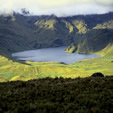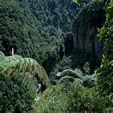|
Climbing and Hiking in Ecuador
By: Mark Thurber, author of "Climbing
and Hiking in Ecuador"
(Brant Guide books, 4th edition) - originally published on the Climbing
and Hiking page of www.ecuadorexplorer.com.
| Introduction | Climbing
in Ecuador |
| Hiking & Trekking in Ecuador | Weather
| Entrance Fees |
| Climbing Huts | Guide Services
| Equipment & Packing |
| Further Reading |
Introduction
Ecuador is one of the smallest countries
in South America, but for climbers and trekkers it offers an incredible
diversity of mountains, ecosystems and cultures to explore. Within
a day's drive of the modern capital city of Quito are 20,000 foot
glaciated peaks, Amazon rainforest, warm coastal beaches, and dense
cloudforest with hidden Incan treasures. Whether you decide to ramble
out on your own or hook up with a local guide service, the logistics
of planning excursions in Ecuador are simpler and the approach time
shorter than in other, more remote, areas of the world.
TOP
Climbing
in Ecuador
The high Andean peaks of Ecuador are located primarily along the
Avenue of the Volcanoes, a fertile central valley, which is buttressed
by two ranges, the Eastern and Western Cordilleras. Most of the
highland populace, including the indigenous Quichua, ekes out an
agrarian living in this region.
Some of the summits are young, cone-shaped volcanoes like Cotopaxi
with technically straight-forward climbs offering the novice a chance
to get near or above 20,000 feet. Others are deeply eroded, older
volcanoes with challenging rock and ice routes (e.g., the glorious
ring of peaks on El Altar).
For your first few days in Ecuador, you should acclimatize by ascending
some of the smaller mountains (15,000 feet or less), such as Iliniza
Norte, Imbabura or Pichincha to avoid developing AMS (Acute Mountain
Sickness). These lower peaks are non-glaciated, easily accessible
within a day's travel from Quito, and offer either hut facilities
or nearby hostels that can be used as a climbing base.
Once your body has adjusted to the altitude, you are ready to try
one of Ecuador's four classic glaciated peaks: Chimborazo, Cotopaxi,
Cayambe or Tungurahua. Although the standard routes are technically
straightforward. Novices should hire a local guide. Experienced
mountaineers can attempt the more remote and/or more difficult peaks
of Antisana, El Altar and Iliniza Sur or the more challenging routes
on the other mountains. As a relatively recent playground for climbers,
Ecuador still provides many opportunities for first ascents on new
routes.
There are three anomalous volcanoes (Reventador, Sumaco and Sangay)
that don't belong to either of the Cordilleras, but rather thrust
up from dense jungle east of the Andes. These climbs have the added
attraction of giving you a chance to test out your machete skills,
as you must blaze trails through dense cloudforest or rainforest
just to get to the base of these giants.
TOP
Hiking
& Trekking
 |
If you prefer hiking and trekking,
there are a number of excellent trips through the Andean paramo
(a sub-alpine zone) which features spectacular views of Ecuador's
volcanic peaks. The most popular treks are the Trek de Condor, which
passes the often cloud-shrouded Antisana, Sincholagua and Cotopaxi
volcanoes; and the Ingapirca trek which takes you along an old Incan
trail to Ecuador's most important Incan ruins, Ingapirca.
For the intrepid trekker there are several Andes-to-Amazon hikes
that take you from the grassy plains of the high altitude paramo,
through cloudforest, and finally to lowland rainforest. During your
descent, as you pass from one ecosystem to another, you'll see dramatic
changes in the flora and fauna while you are peeling off layer after
layer of clothing. At the beginning of your journey, you may be
huddled on a paramo cushion plant as a condor soars overhead; and
a few days later, you could be wiping the sweat off your brow as
you try to get a glimpse of a blue and green macaw squawking in
the crown of a palm tree.
There are numerous route options, since the locals keep most trails
well-trodden. On the Eastern Slope of the Andes heading down to
the Amazon basin, try the routes running from Oyacachi to El Chaco,
Atillo to Macas, or Saraguro to 25 de Mayo. Recommended treks on
the coastal side of the Andes include the Golondrinas hike, Lloa
to Mindo, and Chugchilan to Pucayacu.
Coastal and rainforest hikes are possible, but it's a good idea
to hire a local guide as it is easy to get lost and you're often
traveling though private or community-held land. There are some
great hikes from lodges along the Napo River. For the more adventurous,
a canoe trip along the Tiputini or Yasuni rivers can be arranged
with indigenous guides. Near the coast, an especially interesting
area is the Bilsa Reserve near Quinide. This area is also home to
the Chachi indigenous group.
TOP
Weather
 |
At any given moment in Ecuador,
it is sunny SOMEWHERE and rainy SOMEWHERE. However, it is difficult
to predict the weather ANYWHERE - especially during an El Nino year.
Nevertheless, there are some basic trends.
Each region of the country has two seasons: wet and dry.
Coast: the northern coast is humid between January and June and
dryish for the rest of the year. The southern coast is humid from
January to April and is generally dryer than the north throughout
the year.
Oriente (Amazon Basin): it rains most of the time in the Oriente,
though the period from December to February is usually slightly
drier.
Sierra (Andes): the eastern mountains (including Antisana, El Altar
and Sangay and, to a lesser extent, Cayambe and Tungurahua) are
influenced by the weather patterns of the Amazonian lowlands. The
wettest months are June through August. December and January have
seen the most successful ascents of the difficult El Altar. Ecuadorian
climbers favor February for attempting Antisana, and October through
January for Cayambe.
The western mountains' dry season is late June through early September,
with an additional short dry spell in December and early January.
The wettest months are February to May, with April being the wettest
of all. During the dry season, temperatures tend to dip at night
and high winds can be a problem, particularly in August. The weather
in October and November tends to be variable.
TOP
National
Parks Entrance Fees
Mainland park entrance fees generally run from USD 5 to 10.
TOP
Climbing
Huts (Refugios)
There are huts at Cotopaxi, Chimborazo, Cayambe, Ilinizas, and Tungurahua.
Almost all huts have bunks, stoves, pots/pans and toilets. Some
even have electricity via a generator. The cost per night is around
USD 10. The hut at Cotopaxi has a cellular phone for weather information
and emergencies: 09-9638344. Plans to install cellular phones at
the other refuges have been discussed as well.
TOP
Guide Services
Guide services in Ecuador are a classic example of "you get
what you pay for," so we recommend avoiding the cheapest ones.
There are many agencies and individuals who will take you up Cotopaxi
for nickles, but don't have enough expertise, and they could put
you in a dangerous situation.
TOP
Equipment
and Packing
Climbing and hiking gear can be easily purchased or rented at reasonable
prices in Quito, and with a bit more difficulty in Banos, Riobamba
and Ambato. Because Ecuador's climate is so varied, it is important
to pack well.
TOP
Further
Reading
Climbing
and Hiking in Ecuador 4th ed , Rob Rachoweicki and Mark Thurber,
Bradt 1997. Most complete and up to date guidebook for Ecuador.
Montañas Del Sol by Serrano, Rojas and Landazuri. Campo Abierto,
1994. Spanish language climbing guide to mountaineering in Ecuador.
Travels Amongst the Great Andes of the Equator by Edward Whymper,
1891. The 1880 expedition which first climbed Ecuador's highest
peak, and made seven other first ascents
TOP
| Introduction
| Climbing in Ecuador |
| Hiking & Trekking in Ecuador | Weather
| Entrance Fees |
| Climbing Huts | Guide Services
| Equipment & Packing |
| Further Reading |
*This information was kindly submitted
by www.ecuadorexplorer.com
where it was originally published in their Climbing
and Hiking guide.
|

